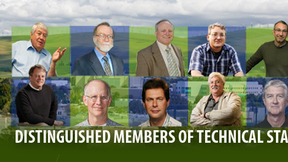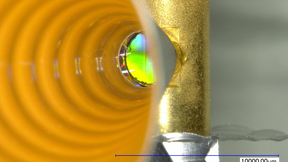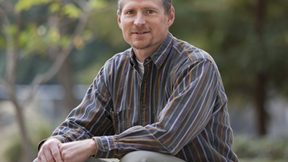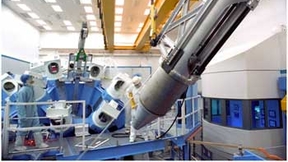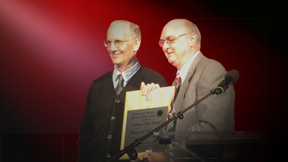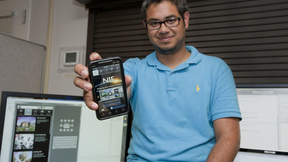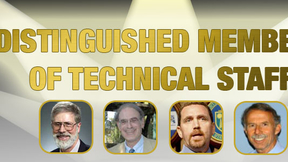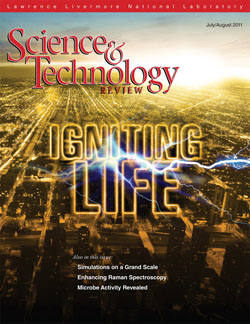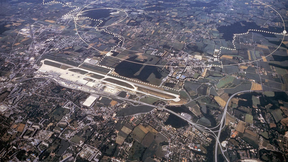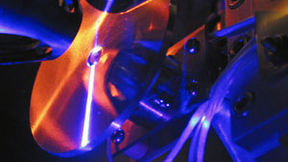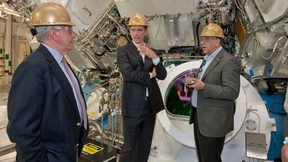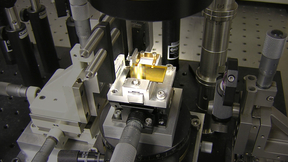Back
The Operations Support Building (OSB) in Bldg. 581 has achieved certification under the Leadership in Energy and Environmental Design (LEED) Green Building Rating System. The OSB, which houses the new Target Alignment System and Final Optics Damage Inspection System alignment labs as well as optics and material handling labs and offices, is the fifth building at LLNL to be…
Ten Laboratory researchers have been named Distinguished Members of Technical Staff (DMTS) for their extraordinary scientific and technical contributions to the Laboratory and its missions as acknowledged by their professional peers and the larger community. Jim Candy of the Engineering Directorate, John Castor of the Weapons and Complex Integration Principal Directorate,…
Lab scientists and international collaborators have created the shortest, purest X-ray laser pulses ever achieved, fulfilling a 45-year-old prediction and ultimately opening the door to new medicines, devices and materials. The researchers, reporting today (Jan. 26) in Nature , aimed radiation from the Linac Coherent Light Source (LCLS), located at the Stanford Linear…
John Edwards, associate program director for inertial confinement fusion (ICF) and high energy density (HED) science at Lawrence Livermore National Laboratory (LLNL), has been selected as a 2011 American Physical Society (APS) fellow. Edwards was cited in the plasma physics category for fundamental contributions to hydrodynamics in HED physics and for his leadership in the…
Christopher Barty, chief technology officer for LLNL's National Ignition Facility and Photon Science Directorate, is one of 75 newly-named fellows of SPIE (the international society for optics and photonics). Barty is recognized for his achievements in a leadership role in the advancement and development of new laser technology. He has published more than 150 manuscripts…
Lab scientists have taken a crucial step toward describing thermonuclear reactions from first principles. Over the past decade, progress has been made in understanding the static properties of light nuclei based on realistic interactions among protons and neutrons. But ab initio calculations of nuclear scattering and reactions have been mostly confined to systems of four…
Mike Dunne, director of Laser Fusion Energy at LLNL, has been awarded the 2011 Excellence in Fusion Engineering Award by Fusion Power Associates (FPA). Dunne received the award Dec. 14 at the FPA's annual meeting and symposium in Washington, D.C. The FPA board chose Dunne for the honor based on his "many technical contributions to high energy density physics and laser…
In the first university-based planetary science experiment at the National Ignition Facility (NIF), researchers have gradually compressed a diamond sample to a record pressure of 50 megabars (50 million times Earth's atmospheric pressure). By replicating the conditions believed to exist in the cores of several recently discovered "super-Earths" - extra-solar planets three…
Steve MacLaren, a physicist with LLNL's Weapons and Complex Integration Principal Directorate, has been recognized with the National Nuclear Security Administration's (NNSA) Defense Programs' Employee of the Quarter Award. Recipients of the awards are recognized for going beyond the call of duty in supporting the mission of NNSA's Defense Programs. "The Defense Programs…
In a unique experiment recently published in Physical Review Letters , researchers used the Omega Laser Facility at the University of Rochester to make precise measurements of a fundamental nuclear process -- the elastic scattering of neutrons off heavy forms of hydrogen. This is the first time a fundamental nuclear physics experiment has been achieved using a high-energy…
LIVERMORE, Calif. -- Bruce Remington, group leader for material dynamics in the National Ignition Facility Directorate's High Energy Density Experiments Program at Lawrence Livermore National Laboratory (LLNL), is the recipient of the 2011 Edward Teller Medal. The Fusion Energy Division of the American Nuclear Society (ANS) presented the award today (Sept. 14), during the…
Like many organizations across the country, summer is a time for an influx of new, fresh faces. LLNL is no different, welcoming hundreds of summer students and interns from near and far. One of those students is Jorge Castro Morales. A computer engineering student at the Universidad del Turabo at Gurabo, Puerto Rico, his interest in the Lab was piqued when a friend who…
The Laboratory has signed a memorandum of understanding to engage in joint research and to promote the exchange of personnel with Spain's Instituto de Fusion Nuclear (IFN), a research institute of the Universidad Politecnica de Madrid (UPM) to explore the highest level of nuclear fusion research. The Laboratory and IFN have had a long history of collaboration; the MOU…
Four Laboratory employees have been named Distinguished Members of Technical Staff (DMTS) for their extraordinary scientific and technical contributions to the Laboratory and its missions as acknowledged by their professional peers and the larger community. John Lindl of the NIF and Photon Science Principal Directorate, Mordy Rosen of the Weapons Complex and Integration…
The July/August 2011 issue of Science & Technology Review is now online . This issue's feature article, "Igniting Our Energy Future," reports on how Livermore researchers are forging a commercial pathway for a revolutionary power plant called LIFE to help the nation meet the increasing demand for safe, clean and sustainable electricity. A second feature highlight's…
Next week, nearly 400 scientists from around the world will converge at the pristine mountains near Lake Tahoe to discuss all aspects of physics related to the fundamental particles of nature, quarks and gluons that form the matter we observe within our visible universe. They also will discuss the physics of new particles that may be discovered at the Large Hadron Collider…
Using an instrument originally developed to probe the minute amounts of stellar dust found in meteorites, Kim Knight has developed a technique to analyze raw materials to determine the fallout from a nuclear explosion. Called Resonance Ionization Mass Spectrometry or RIMS, Knight and LLNL colleague Ian Hutcheon, along with collaborators at Argonne National Laboratory and…
Lt. Gov. Gavin Newsom visited the Laboratory Tuesday afternoon for tours and briefings. After an overview, Newsom listened to presentations about the Industrial Partnerships Office, the Livermore Valley Open Campus, high performance computing, 21st century energy projects and educational outreach. He also toured the Terascale Simulation Facility and the National Ignition…
Lawrence Livermore National Laboratory researchers have captured two awards for developing cutting-edge technologies with commercial potential. A team of LLNL computer scientists and a team of engineers have won awards from the trade journal R&D Magazine for developing advances among the top 100 industrial inventions worldwide for 2010. One of the teams worked with two…
LIVERMORE, Calif. -- By combining high pressure with high temperature, Livermore researchers have created a nanocyrstalline diamond aerogel that could improve the optics for something as big as a telescope or as small as the lenses in eyeglasses. Aerogels are a class of materials that exhibit the lowest density, thermal conductivity, refractive index and sound velocity of…


